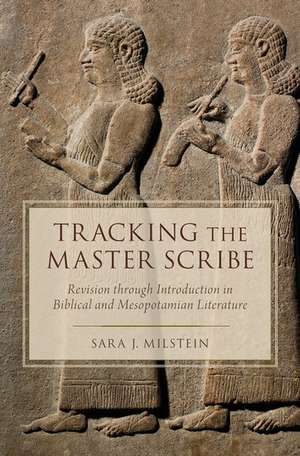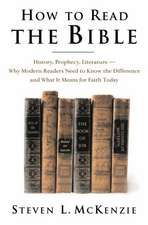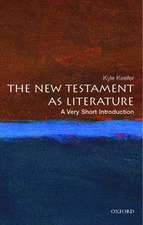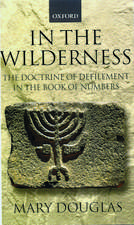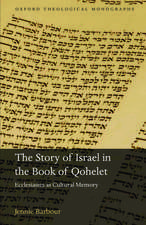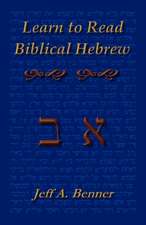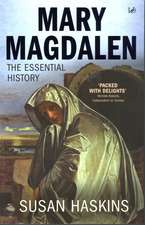Tracking the Master Scribe: Revision through Introduction in Biblical and Mesopotamian Literature
Autor Sara J. Milsteinen Limba Engleză Hardback – 27 oct 2016
Preț: 757.96 lei
Preț vechi: 1091.07 lei
-31% Nou
Puncte Express: 1137
Preț estimativ în valută:
145.04€ • 155.09$ • 120.93£
145.04€ • 155.09$ • 120.93£
Carte tipărită la comandă
Livrare economică 07-12 aprilie
Preluare comenzi: 021 569.72.76
Specificații
ISBN-13: 9780190205393
ISBN-10: 0190205393
Pagini: 264
Ilustrații: 6
Dimensiuni: 155 x 236 x 28 mm
Greutate: 0.45 kg
Editura: Oxford University Press
Colecția OUP USA
Locul publicării:New York, United States
ISBN-10: 0190205393
Pagini: 264
Ilustrații: 6
Dimensiuni: 155 x 236 x 28 mm
Greutate: 0.45 kg
Editura: Oxford University Press
Colecția OUP USA
Locul publicării:New York, United States
Recenzii
Milstein's discussion of revision through introduction is an important addition to recent discussions of the literary history of ancient texts, especially since it is the first monograph devoted to revision through introduction, a scribal technique that obviously was used widely through the ancient Near Eastern and Mediterranean world.
In sum, this book is simply a piece of excellent scholarship.
In her careful and creative study, Milstein offers new evidence and insight, better preparing the reader to wrestle with ancient texts. At the same time, her evidence and insight shake the foundations we previously thought were firm, leaving us both closer and farther from her beloved and elusive scribes. Because of these and other reasons, Milstein's study is to be highly recommended, helping us to recalibrate our thinking and inviting the reader to follow the path she has skillfully laid to see what treasures it yields.
This is a well-written, exciting and programmatic book that makes a great read ... Strongly recommended as a stimulating example of the new wave of textual-historical scholarship.
[Milstein] does not claim that the observation regarding introductions itself is new, but that this is the first book-length study devoted to the subject. She wants to continue the historical-critical enterprise in general, but to do so with a greater understanding of the literary quality of the texts as well as to 'establish more controls for literary-historical analyses'. She brings her knowledge of two related textual corpora to bear, with good results. Her two main ANE test cases are Adapa and the South Wind and Gilgamesh; the two biblical examples are taken from Judges 6-8 and 9. But before she studies these in depth she looks at other examples from a variety of genres (lexical lists, legal texts, narratives) to show how widespread the phenomenon is. The book is a pleasure to read both for its content and its form. Anyone interested in the evolution of ANE texts including the Bible ought to read this book.
There is much to commend in this book. For students looking for an exemplar in moving from the hard data of scribal studies to the interpretive light it provides, [Milstein] is worth emulating. Even when I disagreed with her, I found her observations noteworthy and her analysis stimulating.
In sum, this book is simply a piece of excellent scholarship.
In her careful and creative study, Milstein offers new evidence and insight, better preparing the reader to wrestle with ancient texts. At the same time, her evidence and insight shake the foundations we previously thought were firm, leaving us both closer and farther from her beloved and elusive scribes. Because of these and other reasons, Milstein's study is to be highly recommended, helping us to recalibrate our thinking and inviting the reader to follow the path she has skillfully laid to see what treasures it yields.
This is a well-written, exciting and programmatic book that makes a great read ... Strongly recommended as a stimulating example of the new wave of textual-historical scholarship.
[Milstein] does not claim that the observation regarding introductions itself is new, but that this is the first book-length study devoted to the subject. She wants to continue the historical-critical enterprise in general, but to do so with a greater understanding of the literary quality of the texts as well as to 'establish more controls for literary-historical analyses'. She brings her knowledge of two related textual corpora to bear, with good results. Her two main ANE test cases are Adapa and the South Wind and Gilgamesh; the two biblical examples are taken from Judges 6-8 and 9. But before she studies these in depth she looks at other examples from a variety of genres (lexical lists, legal texts, narratives) to show how widespread the phenomenon is. The book is a pleasure to read both for its content and its form. Anyone interested in the evolution of ANE texts including the Bible ought to read this book.
There is much to commend in this book. For students looking for an exemplar in moving from the hard data of scribal studies to the interpretive light it provides, [Milstein] is worth emulating. Even when I disagreed with her, I found her observations noteworthy and her analysis stimulating.
Notă biografică
Sara J. Milstein is Assistant Professor of Hebrew Bible and Ancient Near Eastern Studies at the University of British Columbia.
